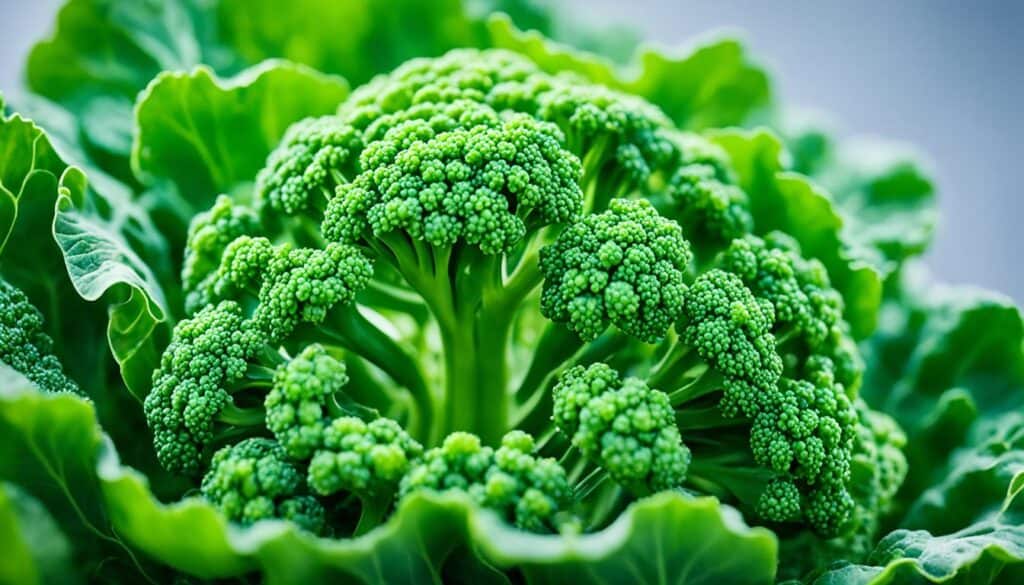Did you know that stem vegetables are not only healthy veggies but also the epitome of plant-based foods? They are a diverse group of vegetable varieties that offer a wide range of health benefits. From nutrient-rich produce to green leafy vegetables, stem vegetables are a fantastic addition to any diet.
In this guide, I will provide you with a list of my favorite stem vegetables, along with their nutritional profiles and tips for incorporating them into your meals. Whether you prefer seasonal produce or organic vegetable options, there is a stem vegetable out there for everyone. Let’s dive in and explore the world of stem vegetables together.
Key Takeaways:
- Stem vegetables are a diverse group of vegetable varieties that offer a wide range of health benefits.
- They are nutrient-rich produce and provide essential vitamins, minerals, and antioxidants.
- Stem vegetables can be incorporated into various dishes and recipes, adding a delicious and nutritious element to your meals.
- Whether you prefer seasonal produce or organic options, there is a stem vegetable out there for everyone’s preferences.
- Exploring the world of stem vegetables can lead to a healthier and more flavorful diet.
Green Banana: A Gut-Supporting Powerhouse
When it comes to adding a nutritional boost to your meals, look no further than the green banana. This versatile fruit is a staple in Latin and Caribbean cuisines and offers numerous health benefits. Packed with resistant starch, green bananas are known for their positive impact on gut health and blood sugar regulation.
Resistant starch is a type of dietary fiber that resists digestion in the small intestine. Instead, it reaches the large intestine where it becomes food for beneficial gut bacteria. This process not only promotes a healthy digestive system but also supports overall gut health. Green bananas can also help regulate blood sugar levels, which is essential for maintaining stable energy levels throughout the day.
One of the significant advantages of incorporating green bananas into your diet is their versatility. They can be roasted to bring out their natural sweetness, added to stews or curries for a delightful texture, or used as a base for smoothies for a nutritious boost. In Latin and Caribbean cuisines, green bananas are often used in traditional dishes like mofongo or tostones, adding a delicious and nutritious element to the meal.
So, whether you’re a fan of Latin cuisine or simply looking to explore new flavors, don’t overlook the green banana. Its rich content of resistant starch and ability to support gut health and blood sugar regulation makes it a true powerhouse in the world of fruits.
A Summary of Green Banana’s Health Benefits:
- Rich in resistant starch, which promotes gut health
- Helps regulate blood sugar levels
- Versatile ingredient in Latin and Caribbean cuisines
- Delicious addition to a variety of dishes
I love incorporating green bananas into my meals. Not only do they add a delightful flavor and texture, but they also provide a natural boost to my gut health and help maintain stable energy levels throughout the day. Give green bananas a try and experience the amazing benefits for yourself.
Golden Beets: Antioxidant-Rich Immunity Boosters
Golden beets, also known as orange-yellow beets, are a fantastic addition to your diet. Not only do they add vibrant color to your plate, but they also offer a plethora of health benefits. These golden gems are packed with antioxidants that provide cell protection and support your body’s natural defense against viruses and bacteria.
Antioxidants are essential for maintaining a strong immune system and overall well-being. Golden beets contain a unique combination of antioxidants that help fight oxidative stress and free radical damage in the body. By incorporating golden beets into your meals, you can fortify your immune system and promote optimal health.
You can enjoy golden beets in various delicious ways. Whether they are roasted, boiled, or added to salads, their earthy and slightly sweet flavor adds depth to any dish. One popular method is to roast them to bring out their natural sweetness and enhance their flavor profile. The versatility of golden beets allows you to experiment with different cooking techniques and recipes.
Not only do golden beets provide a burst of flavor and color to your plate, but they also offer a range of essential nutrients. From vitamins A and C to fiber and potassium, golden beets are a nutrient powerhouse that can support your overall health and well-being.
Adding golden beets to your regular diet is a simple and delicious way to boost your antioxidant intake and support your immune system. So why not give these orange-yellow beauties a try and enjoy the numerous health benefits they have to offer?
Cabbage: Vitamin C and Fiber-Rich Nutritional Powerhouse
Cabbage, a member of the cruciferous vegetable family, is a nutritional powerhouse that offers a host of health benefits. This versatile vegetable is an excellent source of vitamin C and fiber, making it a valuable addition to any diet. Cabbage’s rich content of glucosinolates, plant compounds known for their potential to lower the risk of chronic diseases, including certain types of cancer, further enhances its nutritional profile.
Cabbage can be prepared in a variety of delicious ways, allowing you to enjoy its goodness in any dish. Whether added raw to salads, roasted to bring out its natural sweetness, sautéed for a quick and nutritious side dish, or incorporated into a range of recipes, cabbage provides a delightful and satisfying flavor to your meals.
The Health Benefits of Cabbage
Here are some of the top health benefits of incorporating cabbage into your diet:
- Vitamin C: Cabbage is a rich source of vitamin C, a powerful antioxidant that supports immune function, helps in collagen formation, and promotes overall health and well-being.
- Fiber: With its high fiber content, cabbage aids in digestion, promotes a healthy gut, and helps maintain regular bowel movements.
- Glucosinolates: The glucosinolates found in cabbage have been linked to a reduced risk of chronic diseases, including certain types of cancer.
Incorporating cabbage into your meals not only boosts your nutrient intake but also adds variety and flavor to your plate. Whether enjoyed in classic coleslaw, added to soups and stews, or used as a crunchy taco filling, cabbage offers endless possibilities for tasty and nutritious dishes.
Cabbage Recipes to Try
Here are a few delicious cabbage recipes to inspire your culinary adventures:
- Cabbage Salad: Create a refreshing and crunchy salad by combining shredded cabbage, carrots, and a zesty dressing.
- Stir-Fried Cabbage: Sauté cabbage with garlic, ginger, and soy sauce for a quick and flavorful side dish.
- Roasted Cabbage Wedges: Drizzle cabbage wedges with olive oil, season with salt and pepper, and roast until caramelized for a tasty and visually appealing dish.
- Cabbage Rolls: Stuff blanched cabbage leaves with a delicious filling of your choice, such as rice and vegetables, and bake until tender.
“The world of cabbage is as vast as it is nutritious. Don’t be afraid to experiment and discover exciting ways to incorporate this vitamin C and fiber-rich vegetable into your meals.” – Me
Radish: Crunchy, Hydrating, and Nutritious
When it comes to adding crunch and freshness to your meals, look no further than radishes. These vibrant root veggies are not only visually appealing but also pack a nutritional punch. Radishes are a great source of vitamin C, antioxidants, and dietary fiber, making them a fantastic addition to a healthy diet.
One of the key benefits of radishes is their high vitamin C content. Vitamin C is known for its immune-boosting properties and plays a vital role in maintaining overall health. By incorporating radishes into your meals, you can enhance your immune function and support your body’s natural defense system.
Radishes are also rich in antioxidants, which help protect your cells from damage caused by harmful free radicals. These antioxidants play a crucial role in promoting good health and reducing the risk of chronic diseases.
Furthermore, the fiber content in radishes contributes to a healthy gut. Fiber acts as a prebiotic, providing nourishment for beneficial gut bacteria and promoting a balanced gut microbiome. A healthy gut microbiome is essential for optimal digestion, gut health, and overall well-being.
Another benefit of incorporating radishes into your meals is their role in blood sugar regulation. The fiber content helps slow down the digestion and absorption of carbohydrates, preventing rapid spikes in blood sugar levels. This can be particularly beneficial for individuals with diabetes or those looking to manage their blood sugar levels.
Whether you enjoy radishes sliced thinly and added to salads, or roasted to bring out their natural sweetness, there are countless ways to incorporate these crunchy root veggies into your meals. Their refreshing flavor pairs well with various dishes and adds a delightful crunch to sandwiches, tacos, and grain bowls.
So why not give radishes a try? Not only will they add a burst of color to your plate, but they will also provide your body with essential nutrients for optimal health and well-being.
Radish Nutritional Profile
| Nutrient | Amount per 100g |
|---|---|
| Calories | 16 |
| Carbohydrates | 3.4g |
| Fiber | 1.6g |
| Protein | 0.7g |
| Fat | 0.1g |
| Vitamin C | 14.8mg |
| Potassium | 233mg |
Garlic: Flavorful and Nutrient-Packed
Garlic, with its aromatic and pungent flavor, is a versatile vegetable that adds a delightful taste to a variety of dishes. But did you know that garlic is not just about flavor? It is also packed with an array of nutrients that can support your overall health.
One of the notable benefits of garlic is its high vitamin content. It contains essential vitamins like vitamin C, vitamin B6, and vitamin B1 (thiamine). These vitamins play a crucial role in supporting various bodily functions, including immunity, energy production, and nervous system health.
Garlic also contains dietary fiber, which contributes to a healthy digestive system. Fiber aids in maintaining regular bowel movements and promotes a feeling of fullness, making it beneficial for weight management.
Another remarkable property of garlic is its antibacterial and anti-inflammatory properties. Certain compounds found in garlic, such as allicin, have been shown to possess antibacterial properties that may help fight against harmful bacteria and support a healthy immune system.
Furthermore, garlic is known for its anti-inflammatory effects. It contains sulfur compounds that can help reduce inflammation in the body. By incorporating garlic into your diet, you may potentially alleviate inflammation-related symptoms and contribute to overall well-being.
Roasting garlic releases its umami notes, enhancing the taste of your meals. From spreading it on toast to adding it to savory entrées, roasted garlic infuses dishes with a rich and savory flavor profile.
Cooking with Garlic
Garlic pairs well with various ingredients, particularly rice and grains, creating flavorful and aromatic dishes. It can be cooked with rice, providing a fragrant seasoning that adds depth to your meals. Whether you are preparing a pilaf, risotto, or fried rice, incorporating garlic elevates the flavors and adds a delicious twist.
If you want to experiment further, try making a garlic-infused oil to drizzle over cooked rice or toss with cooked grains like quinoa or barley. This simple addition can take your side dishes to a whole new level of deliciousness.
Additionally, garlic can be chopped and sautéed with vegetables to enhance the taste of stir-fries or incorporated into grain-based salads for an extra burst of flavor.
When it comes to garlic’s versatility, the possibilities are endless. From vibrant pasta dishes to mouthwatering sauces, garlic takes center stage and enhances the overall dining experience. Stay creative and discover new ways to incorporate garlic into your cooking routine.
Remember, whether you enjoy garlic for its flavor or its health benefits, it’s a nutritious ingredient worth adding to your culinary repertoire.
| Nutrient | Amount per 100g |
|---|---|
| Vitamin C | 31.2 mg |
| Vitamin B6 | 0.44 mg |
| Thiamine (Vitamin B1) | 0.2 mg |
| Fiber | 2.1 g |
Carrots: Nutrient-Dense and Vision-Boosting
Carrots are a delicious and versatile vegetable that offers a wide range of health benefits. They are packed with essential nutrients and phytochemicals that promote overall well-being. Let’s explore why carrots are a fantastic addition to your diet.
One of the key nutrients found in carrots is beta-carotene, which the body converts to vitamin A. Vitamin A plays a crucial role in maintaining good vision, especially in low-light conditions. By incorporating carrots into your diet, you can support your eye health and improve your vision naturally.
“Carrots are rich in beta-carotene, which is converted to vitamin A in the body and aids in good vision.”
Carrots also provide vital vitamins and minerals, including vitamins K and C, and potassium. Vitamin K aids in blood clotting and bone health, while vitamin C boosts your immune system. Potassium is essential for maintaining healthy blood pressure levels and proper muscle function.
Fiber is another important component of carrots. It contributes to a healthy digestive system and helps you meet your daily fiber needs. Incorporating shredded carrots into your salads, roasting them as a side dish, or blending them into healthy smoothies are great ways to enjoy the benefits of this nutritious vegetable.
To give you some culinary inspiration, here are a couple of carrot recipes to try:
- Carrot and Ginger Soup:
- Ingredients:
- 2 cups of shredded carrots
- 1 tablespoon minced ginger
- 1 onion, chopped
- 2 cloves of garlic, minced
- 4 cups of vegetable broth
- Salt and pepper to taste
- Fresh cilantro for garnish
- Instructions:
- In a large pot, sauté the onion and garlic until golden.
- Add the shredded carrots and ginger, cooking for a few minutes.
- Pour in the vegetable broth and bring to a boil.
- Reduce heat and simmer for 15-20 minutes.
- Blend the soup until smooth using an immersion blender.
- Season with salt and pepper to taste.
- Garnish with fresh cilantro before serving.
- Ingredients:
- 2 cups of baby carrots
- 1 can of chickpeas, drained and rinsed
- 2 tablespoons olive oil
- 1 teaspoon ground cumin
- 1 teaspoon paprika
- Salt and pepper to taste
- 2 cups mixed salad greens
- ¼ cup crumbled feta cheese
- ¼ cup chopped fresh parsley
- Instructions:
- Preheat oven to 400°F (200°C).
- In a bowl, toss the baby carrots and chickpeas with olive oil, cumin, paprika, salt, and pepper.
- Spread the carrots and chickpeas on a baking sheet and roast for 20-25 minutes, until tender.
- In a salad bowl, arrange the mixed greens.
- Add the roasted carrots and chickpeas.
- Sprinkle with crumbled feta cheese and chopped fresh parsley.
- Toss well and serve.
With their vibrant color, sweet taste, and endless culinary possibilities, carrots are a nutritious and tasty addition to any meal. Start incorporating carrots into your diet and experience the many health benefits they offer.
Broccoli: Cruciferous Vegetable with Micronutrient Power
Broccoli is a cruciferous vegetable that belongs to the same family as cabbage, kale, and cauliflower. It is a nutritional powerhouse, packed with essential vitamins and minerals.
One of the key nutrients found in broccoli is vitamin C, which plays a vital role in supporting our immune system and promoting overall health. Broccoli is also a rich source of vitamins A and K, which are important for vision and bone health, respectively.
Moreover, broccoli contains sulforaphane, a phytochemical that has been linked to potential cancer-fighting properties. Sulforaphane activates the body’s natural detoxification enzymes, helping to eliminate potentially harmful substances and reduce the risk of certain types of cancer.
In addition to its vitamin and sulforaphane content, broccoli is also loaded with antioxidants such as lutein, beta-carotene, and zeaxanthin. These antioxidants are known for their beneficial effects on eye health, as they help protect against age-related macular degeneration and other vision problems.
There are various ways to incorporate broccoli into your diet. You can enjoy it raw, as part of a salad, or try grilling or steaming it to lock in its nutritional benefits. Whether you’re looking to add more low-carb vegetables to your meals or boost your nutrient intake, broccoli is an excellent choice.
Did You Know?
Broccoli is one of the most versatile vegetables. It can be used in a wide range of dishes, from stir-fries and soups to pasta and casseroles. Its mild flavor pairs well with many other ingredients, making it a favorite among home cooks and professional chefs alike.
If you want to make the most of the nutritional benefits offered by broccoli, consider steaming it. Steamed broccoli retains more of its vitamins and minerals compared to other cooking methods, making it a healthier option.
But don’t let the cooking process limit your creativity! Grilled broccoli is also a delicious way to enjoy this cruciferous vegetable. The charred edges and smoky flavor add depth to the natural sweetness of the broccoli.
Including broccoli in your diet is a simple and effective way to optimize your nutrient intake and support your overall health. So, the next time you’re at the grocery store, don’t forget to grab a bunch of fresh broccoli and start reaping the many benefits it has to offer!
Mushrooms: Nutrient-Rich Funghi Powerhouses
Mushrooms are a versatile and nutrient-rich vegetable that comes in many varieties. They are a good source of B vitamins, including niacin, riboflavin, and pantothenic acid. These vitamins have various roles in the body, from making red blood cells to improving digestion and maintaining healthy skin.
Mushrooms also contain bioactive compounds that support cognition, heart health, and disease prevention. These compounds include antioxidants, such as selenium and ergothioneine, which help protect cells from damage and reduce inflammation.
One unique aspect of mushrooms is their ability to produce vitamin D when exposed to sunlight. They are the only non-animal food product with bioavailable vitamin D. This makes mushrooms an excellent option for vegans and vegetarians who may have limited dietary sources of this essential nutrient.
Not only are mushrooms nutritious, but they also offer a variety of culinary possibilities. They can be used as a replacement for meat in many dishes, thanks to their rich umami flavor and meaty texture. Mushrooms can be grilled, sautéed, or steamed to bring out their savory taste. They can also be enjoyed raw in salads or added to a wide range of recipes, from soups and stir-fries to pasta dishes and pizzas.
Mushroom Varieties and Their Benefits
There are numerous mushroom varieties available, each with its own unique flavor and nutritional profile. Here are a few popular types:
| Mushroom Variety | Taste | Key Nutrients |
|---|---|---|
| Button mushrooms | Mild, earthy | Vitamin B2, selenium, potassium |
| Shiitake mushrooms | Rich, savory | Vitamin D, iron, zinc, manganese |
| Portobello mushrooms | Meaty, robust | Vitamin B3, phosphorus, copper |
| Oyster mushrooms | Mild, delicate | Protein, fiber, potassium |
These are just a few examples, and there are many more exciting mushroom varieties to explore.
Delicious Mushroom Recipes
Here are a couple of mouth-watering mushroom recipes to inspire you:
- Mushroom Risotto: Creamy, flavorful, and packed with umami, mushroom risotto is a classic Italian dish that highlights the rich taste of mushrooms. It’s the perfect comfort food for a cozy dinner.
- Stuffed Mushrooms: These bite-sized treats are filled with a delicious mixture of breadcrumbs, herbs, and cheese. They make excellent party appetizers or a savory snack.
Remember to always cook mushrooms thoroughly to ensure optimal taste and maximum nutrient availability.
With their impressive nutrient profile and culinary versatility, mushrooms are a fantastic addition to any diet. Whether you’re looking to improve cognition, support heart health, or simply enjoy delicious vegan and vegetarian dishes, mushrooms are the perfect choice.
Kale: Nutrient-Dense Superfood Leafy Green
Kale is a nutrient-dense leafy green that is often hailed as a superfood, packed with a wide array of vitamins and minerals. Whether you enjoy it raw or cooked, kale is a healthy addition to your diet. Let’s explore the nutritional benefits and various ways to incorporate kale into your meals.
Nutrient Profile of Kale
Kale is rich in vitamins A, B6, C, and K, as well as minerals like potassium, calcium, copper, and manganese. These vitamins and minerals play important roles in supporting overall health and wellbeing. Vitamin A helps with vision, B6 supports brain development and function, vitamin C boosts immunity, and vitamin K aids in blood clotting and bone health. Meanwhile, minerals like potassium, calcium, copper, and manganese contribute to various bodily functions, from maintaining a healthy heart to supporting proper bone formation.
Antioxidants for Health and Protection
One of the key features of kale is its high antioxidant content. Kale contains a group of antioxidants called glucosinolates, which have been shown to have protective effects against certain types of cancer. These antioxidants help combat oxidative stress and reduce inflammation in the body, promoting optimal health and well-being.
Raw Kale vs. Steamed Kale
When it comes to enjoying kale, you have the option of consuming it raw or steamed. Raw kale provides the highest nutritional value, as cooking can reduce some of its vitamins and minerals. However, steaming kale retains the most antioxidants, making it a great choice for preserving the health benefits of this leafy green. Whether you prefer raw kale in salads or steamed kale as a side dish, both options offer valuable nutrients for your body.
Incorporating Kale into Your Diet
There are countless ways to incorporate kale into your meals. Here are a few ideas to get you started:
- Add raw kale leaves to your favorite salad for an extra nutritional boost.
- Sauté kale with garlic and olive oil for a simple and flavorful side dish.
- Blend kale into smoothies for a refreshing and nutrient-packed drink.
- Bake kale chips in the oven for a crunchy and healthy snack.
Get creative with kale and experiment with different kale recipes to discover your favorite way to enjoy this nutrient-dense superfood.
Turnips: Versatile Root Vegetable with Excellent Nutrition Profile
Turnips are a versatile root vegetable that come in various colors, including purple, red, and green. They are rich in fiber, micronutrients like vitamin C, folate, and potassium, and have an excellent nutritional profile.
Turnips are relatively inexpensive and have a neutral taste, making them easy to add to a variety of recipes. They can be roasted or mashed as a lower-carb swap for potatoes, adding flavor, texture, and nutritional benefits to your meals.
The Nutritional Profile of Turnips:
| Nutrient | Amount per 100g |
|---|---|
| Fiber | 1.8g |
| Vitamin C | 21mg |
| Folate | 15mcg |
| Potassium | 233mg |
Incorporating turnips into your diet is a smart choice for including a nutrient-rich vegetable in your meals. Whether you choose to enjoy them roasted or mashed, turnips provide a delicious way to boost your fiber intake, while also providing essential vitamins and minerals.
Conclusion
Stem vegetables, such as green bananas, golden beets, radishes, and mushrooms, are not only delicious but also incredibly nutritious. These nutrient-dense foods are packed with essential vitamins, minerals, antioxidants, and fiber, making them an excellent choice for promoting overall health and well-being.
By incorporating stem vegetables into your meals, you can boost your nutrient intake and enjoy a wide range of health benefits. These vegetables support gut health, promote immune function, and reduce the risk of chronic diseases. Whether you prefer to enjoy them raw, cooked, or in a variety of delicious recipes, stem vegetables offer versatility and endless culinary possibilities.
So why not start exploring the diverse world of stem vegetables? Experiment with new flavors, try different cooking methods, and discover unique combinations that suit your taste buds. Incorporating stem vegetables into your diet is a simple and effective way to add more nutrient-dense foods to your meals and enhance your overall nutrition.










Leave a Reply